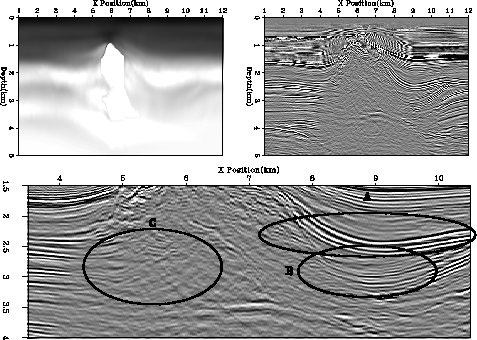




Next: Conclusions
Up: R. Clapp: Dealing with
Previous: Tomography Review
The previous section discussed a method to reduce the
number of bad data points. Another approach is to
limit their effect in the inversion. Generally we do
not iterate to convergence. Early iterations tend to concentrate
on large residuals. Erroneous data points tend to cause
the large residuals. The result is that our solutions tend
to be dominated by these erroneous data points.
A method to combat this problem is to change our misfit
functional from the traditional
|  |
(6) |
There are two different methods to change the misfit function.
The first is to use a non-linear solver.
With a non-linear solver there are a variety of misfit functions,
most interestingly the  and Huber functionals Claerbout (1996); Clapp and Brown (1999); Huber (1973).
A second approach is reweighted least-squares, Guitton (2000); Nichols (1994).
In reweighted least-squares a weighting operator is applied
to the residuals based upon the size of residuals at certain
points in the inversion.
and Huber functionals Claerbout (1996); Clapp and Brown (1999); Huber (1973).
A second approach is reweighted least-squares, Guitton (2000); Nichols (1994).
In reweighted least-squares a weighting operator is applied
to the residuals based upon the size of residuals at certain
points in the inversion.
The total non-linear approach has fewer parameters to manipulate
and is generally more robust than reweighted approach. The downside
of the completely non-linear approach is that it is significantly slower
(a factor of ten or more is not uncommon).
I chose the reweighted least-squares approach because I am most
interested in finding and minimizing the effect of the largest residuals.
I found that a single calculation of the weighting function after
 of the total number of iterations was sufficient
to minimize the most troublesome residuals.
Figure 7 shows the velocity and migration result using
an L1 norm.
Note the improvement in image quality over either of the previous
approaches (Figures 4 and 5).
The salt bottom is more continuous, `A'. The valley structure
is better defined, `B'. The reflectors are more continuous and
extend closer to the salt at `C'.
of the total number of iterations was sufficient
to minimize the most troublesome residuals.
Figure 7 shows the velocity and migration result using
an L1 norm.
Note the improvement in image quality over either of the previous
approaches (Figures 4 and 5).
The salt bottom is more continuous, `A'. The valley structure
is better defined, `B'. The reflectors are more continuous and
extend closer to the salt at `C'.
combo.vel1.steer
Figure 7 Data after one non-linear iteration using a reweighted least-squares.
The top-left panel shows the velocity
model and the top-right panel shows the migrated
image using this velocity.
The bottom panel shows a zoomed area around the salt body.
Note the salt
bottom,`A'; the valley structure at `B'; and under the salt over-hang at `C'.
Note the improved image quality compared to Figure 4 and
Figure 5.
![[*]](http://sepwww.stanford.edu/latex2html/movie.gif)










Next: Conclusions
Up: R. Clapp: Dealing with
Previous: Tomography Review
Stanford Exploration Project
11/11/2002
![]() of the total number of iterations was sufficient
to minimize the most troublesome residuals.
Figure 7 shows the velocity and migration result using
an L1 norm.
Note the improvement in image quality over either of the previous
approaches (Figures 4 and 5).
The salt bottom is more continuous, `A'. The valley structure
is better defined, `B'. The reflectors are more continuous and
extend closer to the salt at `C'.
of the total number of iterations was sufficient
to minimize the most troublesome residuals.
Figure 7 shows the velocity and migration result using
an L1 norm.
Note the improvement in image quality over either of the previous
approaches (Figures 4 and 5).
The salt bottom is more continuous, `A'. The valley structure
is better defined, `B'. The reflectors are more continuous and
extend closer to the salt at `C'.

![[*]](http://sepwww.stanford.edu/latex2html/movie.gif)